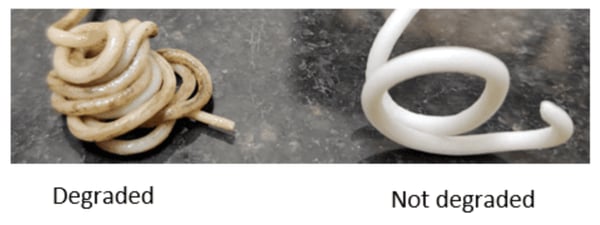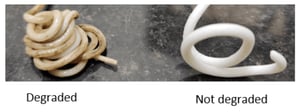Thermal degradation is a type of polymer degradation in which damaging chemical changes happen at elevated temperatures. "The onset of thermal degradation dictates the maximum temperature at which a polymer can be used," which is a critical parameter to consider when processing and manufacturing the polymer. Polymer processing techniques, such as extrusion, hot press, injection molding, and blow molding involve heating the
polymer to above the melting point. Understanding the degradation process of polymers is useful in predicting thermal stability of polymeric products and is important in the design of polymeric materials to improve properties. To prevent degradation of the polymers it is crucial to understand both the melting temperature and the degradation temperature of the polymer material to prevent thermal degradation of your materials. The chemical reactions that result from thermal degradation of polymers result in changes to molecular weight, which can be detected using viscosity measurements.

Thermal degradation of acidic polymer solutions can be monitored by the corresponding drops in viscosity. In an experiment we conducted, we demonstrate that lowering the pH and/or increasing the temperature of acidic solutions leads to larger drops in viscosity over a period of 2 – 3 hours and, hence, enhanced degradation.
Guar gum is a galactomannan polysaccharide often used as a thickening, emulsifying, and stabilizing agent in food products, as well as in the petrochemical and other nonfood industries in applications requiring high viscosities. Guar gum can be partially hydrolyzed to lower molecular weight saccharides under strong acidic and higher temperature conditions, affecting its thickening and stabilizing properties. This degradation process occurs over multiple hours and can be monitored by measuring the corresponding decrease in viscosity over time. We have measured viscosities of guar gum solutions with varying pH and temperature over time to understand how these factors affect the thermal degradation process.
The RheoSense VROC® initium one plus is the leading automated high-throughput viscometer, offering the ability to perform different types of measurements with little volume of sample. The VROC initium one plus automated viscometer can probe the viscosity and thermal degradation of fully contained acidic polymer solutions over relatively large periods of time with minimal evaporation.
Want to learn more about how you can use our automated viscometer to probe thermal degradation of your polymer solutions? Contact us to speak with one of our rheology experts!
Written by: Eden Reid, RheoSense Senior Marketing and Sales Operations



COMMENTS